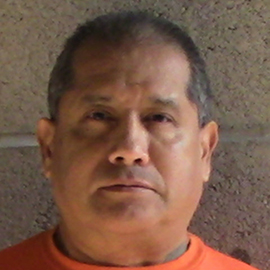- Slug: BC-CNS-Capital Cases,1060
- 3 file photos available (thumbnails, captions below)
By Brooke Newman and Alyssa Marksz
Cronkite News
WASHINGTON – The Supreme Court said it will consider whether two Arizona death-row inmates should get new hearings on claims that attorneys who represented them decades ago failed to present evidence that could have spared them.
A federal appeals court agreed that David Ramirez’s attorney failed to present evidence of a “truly deplorable” childhood and intellectual disability during his trial for the 1989 murder of his girlfriend and her daughter.
It also said Barry Lee Jones’ attorney did not present medical evidence that could have questioned his role in the 1994 murder of his girlfriend’s 4-year-old daughter.
But the Arizona Attorney General’s Office appealed, saying the rulings by the 9th U.S. Circuit Court of Appeals were “precisely the opposite” of a federal law that severely limits such challenges after the fact. The high court on Monday agreed to hear the consolidated cases in the term that begins in October.
A spokesperson said Attorney General Mark Brnovich welcomes the court’s decision to hear the cases, saying that those “who commit the ultimate crimes deserve the ultimate punishment.”
“Far too often we focus on the convicted killers in these cases, meanwhile the victims’ families continue to suffer as justice gets further delayed,” said Katie Conner, the spokesperson for Brnovich.
A federal public defender for Arizona said his office was “disappointed” that the Supreme Court agreed to hear the case, but is “confident that it will reach the right results on the merits.”
“As the uniform decisions of the courts of appeals have recognized, ineffective assistance of counsel claims depend on developing additional evidence outside of a trial record,” said Dale Baich, the assistant federal public defender. “Adopting the state’s position in this case would bar that development, misread the relevant statutory language and upend settled Supreme Court precedent.”
In its brief urging the Supreme Court to reject the case, defense attorneys said the state was trying to “manufacture a problem where none exists…. both cases were decided correctly and straightforwardly” by lower courts.
The two crimes go back three decades. But the latest turn in each case goes back to 2019, when the circuit court ruled separately in the inmates’ favor based on a 2012 Supreme Court decision that created a narrow exception to the Antiterrorism and Effective Death Penalty Act (AEDPA). That law made it harder for federal courts to reopen cases that have been decided by state courts.
Ramirez was convicted for the May 25, 1989, murder of his girlfriend, Mary Gortarez, and her 15-year-old daughter at the girlfriend’s Phoenix apartment.
Police, who were called to the apartment after neighbors reported sounds of a struggle, found Ramirez intoxicated and covered in blood inside the apartment and the two victims dead. Gortarez had been stabbed 18 times and her daughter suffered 15 stab wounds, in addition to evidence that she had been sexually assaulted by Ramirez before she died. Neither victim died immediately, records indicate.
Ramirez was convicted in 1990 on two counts of first-degree murder and sentenced to death after the judge did not find mitigating circumstances that offset the aggravating circumstances of multiple murders committed in a “heinous, cruel or depraved” manner.
Jones was convicted in connection with the death of his girlfriend’s 4-year-old daughter, who was pronounced dead on arrival at Kino Community Hospital in Tucson early on the morning of May 2, 1994. Court documents said the cause of death was determined to be “a small bowel laceration due to blunt abdominal trauma.” The girl also had injuries to her left scalp and her vagina and was found to have internal and external bruising.
Witnesses said they saw the girl in Jones’ care in the hours before her death, and some said they saw him beat her that afternoon.
Jones was charged with murder, sexual assault and three counts of child abuse and convicted on all charges in April 1995. Despite a troubled family background, he was sentenced to death based on the age of the victim and the “especially cruel” nature of the killing.
In subsequent appeals, both Jones and Ramirez argued that their convictions were based on a failure to provide evidence at trial that could have changed the outcome of their cases.
Ramirez claims his trial attorney failed to present evidence of the defendant’s low IQ and a history of abuse, sexual assault, neglect and developmental issues that even a dissenting judge said pointed to the “truly deplorable conditions of his upbringing.”
Jones said his attorney failed to produce expert witnesses who would have said the injuries that killed the girl could have been inflicted days before her death, not just in the hours when she was in his custody.
Separate three-judge panels of the 9th Circuit agreed, ruling that Jones should have a new trial and Ramirez should have a chance to develop evidence that his attorney failed him. The court rejected a request to reconsider the rulings, which brought a sharp dissent from eight circuit judges who accused the panels of creating a “new judge-made exception to … strict limitations on expansion of the evidentiary record” in such cases.
The attorney general’s office agreed with the dissent, arguing that the AEDPA prohibits a federal court from considering evidence outside the state court record in a case except in very narrow circumstances, neither of which applies in these cases.
Unless the appeals court is overturned, Brnovich’s office said, states will “become inundated by resource-intensive litigation, resulting in still more delay and expense” in trials. Thirteen states filed a brief in support of Arizona’s position.
But Robert Dunham, executive director at the Death Penalty Information Center, said other courts agree that defendants should be allowed to raise arguments of poor legal representation.
“Every circuit court in the country that has addressed this issue has said if counsel post-conviction was ineffective, and because of that the issue is not properly litigated in state court, you get to present new facts about that issue when you’re in federal court,” Dunham said Tuesday.
Dunham said that since passage of the AEDPA in 1996, there have been numerous cases in which federal judges believed the defendant was unconstitutionally convicted or sentenced to death but have been powerless to act.
“The AEDPA has unquestionably led to the execution of people who are unconstitutionally convicted and sentenced to death, there is no question about that,” Dunham said.
For more stories from Cronkite News, visit cronkitenews.azpbs.org.
^__=
Web links:
_ AEDPA: https://www.law.cornell.edu/uscode/text/28/2254
_ Ramirez circuit court ruling: http://cdn.ca9.uscourts.gov/datastore/opinions/2019/09/11/10-99023.pdf
_ Jones circuit court ruling: http://cdn.ca9.uscourts.gov/datastore/opinions/2019/11/29/18-99006.pdf
_ Arizona petition: https://www.supremecourt.gov/DocketPDF/20/20-1009/166813/20210120132000573_Ramirez%20Jones%20Petition.pdf
_ Defense motion: https://www.supremecourt.gov/DocketPDF/20/20-1009/173295/20210329184333568_2021.03.29%20Shinn%20Brief%20in%20Opposition.pdf
_ En banc dissent: https://cdn.ca9.uscourts.gov/datastore/opinions/2020/08/24/10-99023.pdf
_ States’ amicus brief: https://www.supremecourt.gov/DocketPDF/20/20-1009/170181/20210226134023599_20-1009%20Amici%20Brief.pdf
_ Death row: https://corrections.az.gov/public-resources/death-row
_ Supreme Court orders list: https://www.supremecourt.gov/orders/courtorders/051721zor_6537.pdf
^__=
The Supreme Court has agreed to hear Arizona’s appeal of a federal circuit court ruling that said two death row inmates should get new hearings for evidence that their attorneys failed to present at their original trials decades ago. (Photo courtesy Arizona Department of Corrections, Rehabilitation and Reentry)
David Ramirez has been on death row for more than 30 years for the 1989 stabbing deaths of Mary Gortarez and her daughter, 15, in their Phoenix apartment. (Photo courtesy Arizona Department of Corrections, Rehabilitation and Reentry)
Barry Lee Jones has been on death row since 1995 for the sexual assault and murder of his girlfriend’s 4-year-old in Tucson. (Photo courtesy Arizona Department of Corrections, Rehabilitation and Reentry)


